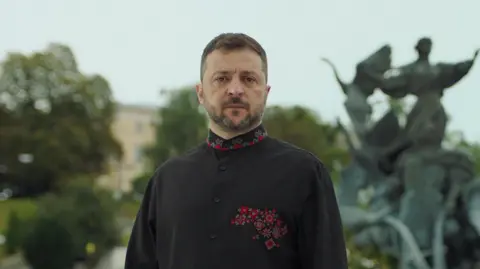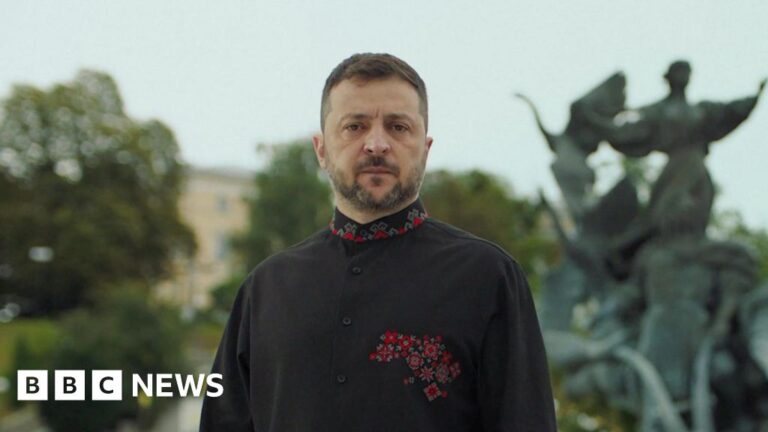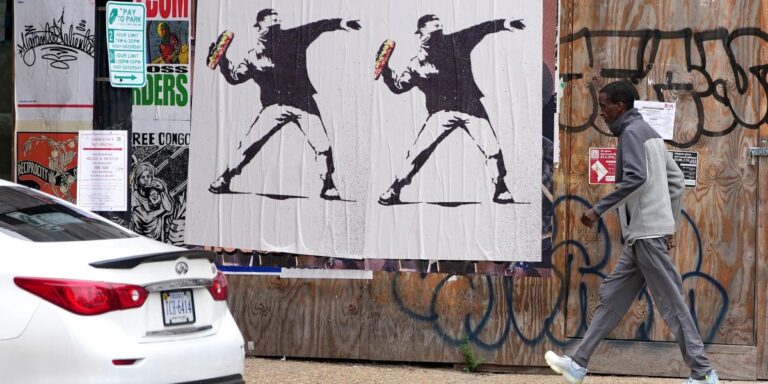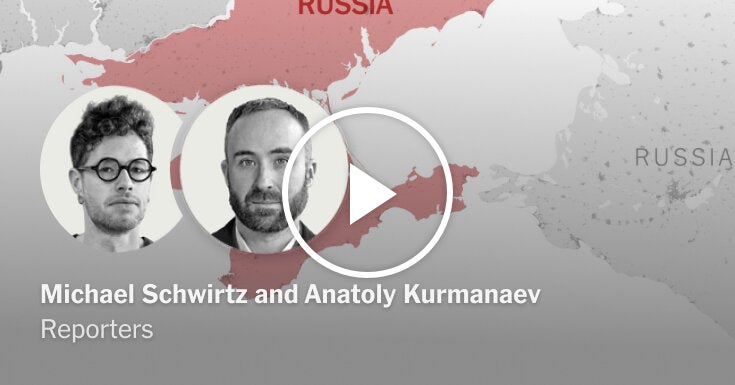 Public Broadcasting company of Ukraine
Public Broadcasting company of UkrainePresident Volodymyr Zelensky said Ukraine would continue to fight for its freedom in an address to the nation on its independence day.
“We need a just peace, a peace where our future will be decided only by us,” he said, adding that Ukraine would fight back against Russia “while its calls for peace are not heard”.
He continued: “Ukraine has not yet won, but it has certainly not lost.”
Zelensky’s remarks came after Moscow said Ukraine had attacked Russian power and energy facilities overnight, blaming drone attacks for a fire at a nuclear power plant in its western Kursk region.
There were no injuries and the fire was quickly extinguished, the plant’s press service said on messaging app Telegram. It said the attack had damaged a transformer, but radiation levels were within the normal range.
The United Nations’ International Atomic Energy Agency (IAEA) said it was aware of reports regarding the fire, while its director general added that “every nuclear facility must be protected at all times”.
The IAEA has repeatedly called on both Russia and Ukraine to show maximum restraint around nuclear facilities in the war.
Independence Day celebrations were held in Kyiv, as the country marked its declaration of independence from the Soviet Union in 1991.
Canada’s Prime Minister Mark Carney took part in the celebrations, and stood beside Zelensky at St Sophia’s Cathedral as he addressed the crowd:
“I want to say something very simple and important: Canada will always stand shoulder to shoulder with Ukraine.”
He said drones, ammunition and armoured vehicles worth more than $1bn Canadian dollars (£534m) would be delivered to Ukraine as early as September, Ukrainian media reported. The deliveries would make up more than half of a support package he announced in July.
Also present was US envoy Keith Kellogg – whom Ukrainian media reported was awarded the Order of Merit, first degree by Zelensky during the ceremony.
After Zelensky thanked him and US President Donald Trump for their support, Kellogg could be heard telling Zelensky: “We’re going to make this work”.
 EPA
EPAAndriy Yermak, Zelensky’s chief of staff, wrote on Telegram early on Sunday: “On this special day – Ukraine’s Independence Day – it is especially important for us to feel the support of our friends. And Canada has always stood by us.”
Meanwhile, Zelensky shared a letter from King Charles sending the people of Ukraine his “warmest and most sincere wishes”.
“I keep feeling the greatest and deepest admiration for the unbreakable spirit of the Ukrainian people,” the King writes. “I remain hopeful that our countries will be able to further work closely together to achieve a just and lasting peace.”
Zelensky said the King’s “kind words are a true inspiration for our people during the difficult time of war”.
The UK government also said Ukrainian flags would appear above Downing Street in recognition of the anniversary.
The Ministry of Defence has confirmed that British military experts will continue to train Ukrainian soldiers until at least the end of 2026, with an extension to Operation Interflex – the codename given to the UK Armed Forces’ training programme for Ukrainian recruits.
Norway announced on Sunday that it would contribute about 7 billion kroner (£514m; $693m) of air defence systems to Ukraine.
“Together with Germany, we are now ensuring that Ukraine receives powerful air defence systems,” Norwegian Prime Minister Jonas Gahr Store said in a statement.
The two nations are funding two Patriot systems, including missiles, with Norway also helping procure air defence radar.
Also on Sunday, Ukraine and Sweden announced they had agreed to joint defence production, with Sweden’s defence minister saying it would “boost Swedish rearmament and meet the needs of Ukraine’s armed forces”.
Pål Jonson wrote on X: “Ukraine will share and provide technology for its factories in Sweden and defence materiel co-produced in Sweden will be exported to Ukraine.”
 Reuters
ReutersOn Saturday, Russia said its forces in eastern Ukraine had seized two villages in the Donetsk region.
Russian forces have been advancing very slowly, and at great cost, in eastern Ukraine and now control about 20% of Ukraine’s territory.
A full-scale invasion of Ukraine was launched by Russia in February 2022.
There has been intense diplomacy over the war this month, with US President Donald Trump meeting his Russian counterpart President Vladimir Putin in Alaska on 15 August.
The summit was billed as a vital step towards peace in Ukraine. However, despite both leaders claiming the talks were a success, Trump has since shown growing frustration publicly over the lack of a peace deal between Russia and Ukraine.
The US president has said he is considering either hitting Russia with further economic sanctions or walking away from peace talks.
“I’m going to make a decision as to what we do and it’s going to be, it’s going to be a very important decision, and that’s whether or not it’s massive sanctions or massive tariffs or both, or we do nothing and say it’s your fight,” Trump said on Friday.
Zelensky has repeatedly called for an unconditional ceasefire and his European allies have also insisted on a halt in fighting.
He has accused Russia of “doing everything it can” to prevent a meeting with Putin to try to end the war.
Russia’s Foreign Minister Sergei Lavrov said Putin was ready to meet Ukraine’s leader “when the agenda is ready for a summit, and this agenda is not ready at all”, accusing Zelensky of saying “no to everything”.


















